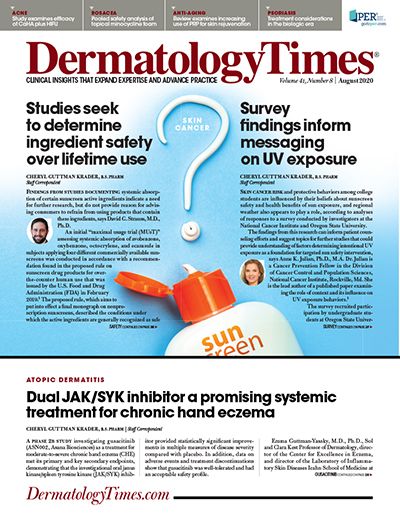- Case-Based Roundtable
- General Dermatology
- Eczema
- Chronic Hand Eczema
- Alopecia
- Aesthetics
- Vitiligo
- COVID-19
- Actinic Keratosis
- Precision Medicine and Biologics
- Rare Disease
- Wound Care
- Rosacea
- Psoriasis
- Psoriatic Arthritis
- Atopic Dermatitis
- Melasma
- NP and PA
- Skin Cancer
- Hidradenitis Suppurativa
- Drug Watch
- Pigmentary Disorders
- Acne
- Pediatric Dermatology
- Practice Management
- Prurigo Nodularis
- Buy-and-Bill
Publication
Article
Dermatology Times
Studies examine ingredient safety over lifetime use
Author(s):
Findings of initial studies and call for further testing should not be misconstrued to mean ingredients are unsafe.
Findings from studies documenting systemic absorption of certain sunscreen active ingredients indicate a need for further research, but do not provide reason for advising consumers to refrain from using products that contain these ingredients, says David G. Strauss, M.D., Ph.D.
An initial “maximal usage trial (MUsT)” assessing systemic absorption of avobenzone, oxybenzone, octocrylene, and ecamsule in subjects applying four different commercially available sunscreens was conducted in accordance with a recommendation found in the proposed rule on sunscreen drug products for over-the-counter human use that was issued by the U.S. Food and Drug Administration (FDA) in February 2019.1
The proposed rule, which aims to put into effect a final monograph on nonprescription sunscreens, described the conditions under which the active ingredients are generally recognized as safe and effective (GRASE). The MUsT design captures ingredient absorption into the blood under the condition of maximal recommended use per the product’s labeling, explained Dr. Strauss, director, Division of Applied Regulatory Science, US FDA, Silver Spring, Md.
The results from the initial MUsT showed that all of the sunscreen ingredients tested were absorbed systemically and detectable in plasma for at least three days after the last of 16 applications (four times a day x four days).
Results of a follow-up study involving four sunscreen products containing avobenzone, oxybenzone, octocrylene, homosalate, octisalate, and octinoxate showed those sunscreen ingredients were present at appreciable concentrations in plasma of blood samples collected after a single application and under maximal-use conditions.2
In both studies, the plasma concentrations of the sunscreen ingredients exceeded the level set in the FDA’s proposed rule that would potentially waive additional safety studies.
Addressing the clinical relevance of the information, Dr. Strauss says that the fact that the sunscreen active ingredients were detectable in the blood should not be interpreted as meaning that the FDA considers the ingredients as unsafe. Nor does the fact that the agency is seeking more information through further safety testing indicate that the FDA believes sunscreen ingredients are unsafe, he adds.
“The study findings pointed to a need for further testing to determine the safety of the ingredients for repeated use over a lifetime,” Dr. Strauss explains.
“In the meantime, patients should continue to be counseled to use SPF 15 or higher broad-spectrum sunscreens along with other sun-protective measures because these interventions have known benefit for preventing skin cancer and protecting the skin from sunburn and other ultraviolet light-induced damage.”
Context for conducting the studies
In light of safety concerns that had emerged pertaining to certain sunscreen active ingredients and the lack of nonclinical safety assessment data for many of the active ingredients, the FDA described specific safety data in the proposed rule that would be needed to determine whether an active ingredient is GRASE for use in sunscreens.
Because MUsTs had not been performed previously for sunscreens, the FDA undertook two trials to demonstrate the feasibility of these studies and collect preliminary data that covered multiple formulations with seven different sunscreen active ingredients, Dr. Strauss explains.
He notes that the call for further testing to determine the safety of the sunscreen active ingredients for repeated use over a lifetime is part of the standard premarket safety evaluation of most chronically administered drugs that have appreciable systemic absorption.
“The data on absorption are then considered with other data from nonclinical toxicology studies and other clinical testing to inform an overall benefit-risk evaluation,” Dr. Strauss says.
As noted in the proposed rule, the FDA identified 12 sunscreen active ingredients that lack sufficient data to support a positive GRASE determination – cinoxate, dioxybenzone, ensulizole, homosalate, meradimate, octinoxate, octisalate, octocrylene, padimate O, sulisobenzone, oxybenzone, and avobenzone. The FDA determined that additional data on the safety of zinc oxide and titanium dioxide were not needed.
As another update, Dr. Strauss notes that the Coronavirus Aid, Relief, and Economic Security Act that was enacted on March 27, 2020, introduced reformed procedures for establishing requirements for OTC monograph drugs, including sunscreens.
“However, the act did not change the applicable standards for determining safety and effectiveness,” he says.
Further discussion of the FDA proposed rule, the findings and relevance of the agency’s sunscreen absorption studies, and patient counseling considerations can be found in a recently published commentary on the American Society of Clinical Oncology’s Policy Statement on Skin Cancer Prevention written by Dr. Strauss and his colleague Theresa M. Michele, M.D., director of the Office of Nonprescription Drugs at the FDA.3
References:
1 Matta MK, Zusterzeel R, Pilli NR, et al. JAMA. 2019;321(21):2082-2091.
2 Matta MK, Florian J, Zusterzeel R, et al. JAMA. 2020;323(3):256-267..
3 Strauss DG, Michele TM. JCO Oncol Pract. 2020;OP2000425. Published online June 30, 2020.






